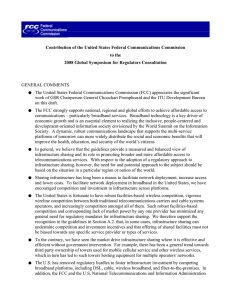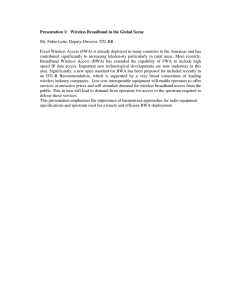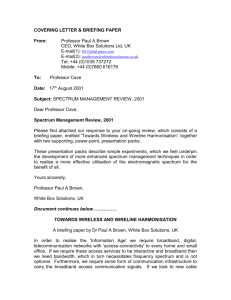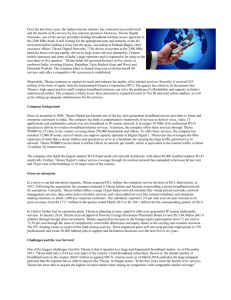Connected & On the Go: Broadband Goes Wireless
advertisement
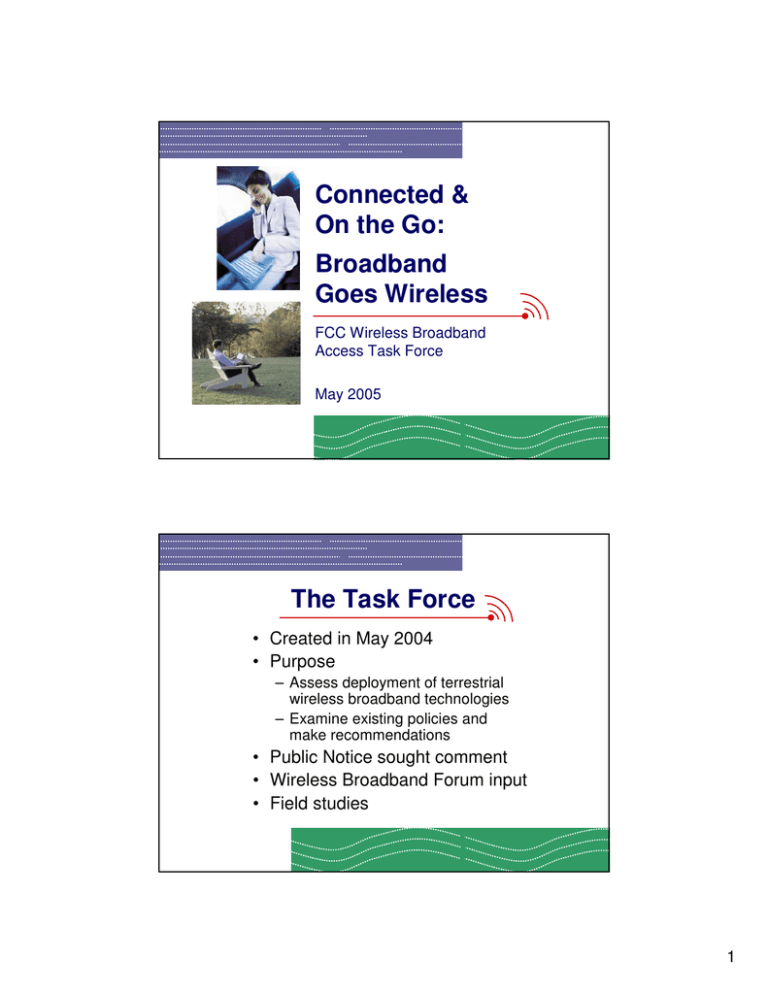
Connected & On the Go: Broadband Goes Wireless FCC Wireless Broadband Access Task Force May 2005 The Task Force • Created in May 2004 • Purpose – Assess deployment of terrestrial wireless broadband technologies – Examine existing policies and make recommendations • Public Notice sought comment • Wireless Broadband Forum input • Field studies 1 Wireless Broadband Defined • • • Speeds ranging from 300 kbps to over 100 Mbps Digital, IP-based Licensed or unlicensed spectrum Communicating across the room or around the world Personal Networks Speed Local Networks Metropolitan Networks Mobile Networks Personal: arm’s length (Bluetooth, UWB) Local: building-wide (WiFi) Metropolitan: city-wide (WiMAX) Mobile: nationwide (3G, EV-DO) Distance Wireless Broadband Attributes • Portability and mobility • Seamless connectivity • Simplicity • Off-the-shelf • Critical role in reaching rural areas 2 Growth in Mobile Broadband Mobile Broadband Deployment in the United States (January 2005) CDMA 1xEV-DO WCDMA/UMTS Flash-OFDM Growth in Wi-Fi Wi-Fi Hotspots Worldwide by Type of Location (2001-2005) 160,000 140,000 120,000 Other Community Hotspots Stations and Ports Enterprise Guesting Areas 100,000 80,000 Retail Outlets Hotels Airports 60,000 40,000 20,000 2001 Source: Gartner Dataquest, June 2003 2002 2003 2004E 2005E 3 Wireless Internet Service Providers • Small, often “mom-and-pop” businesses, using license exempt spectrum to provide broadband services to rural and underserved areas – between 4,000-8,000 in U.S. • Networks aren’t just “last mile,” they are often last 30 or 50 miles Sampling of Services • • • • • • Access to Broadband Community Networking Economic Development Education Telemedicine Basic Telephone Service Through Voice Over IP (VoIP) 4 Few Barriers to Entry • Relatively low equipment costs • Off-the-shelf or readily available equipment for consumers and small businesses • Access to spectrum -- most WISPs operate in exclusively in unlicensed spectrum, therefore spectrum access is free • Flexibility in regulations – type of technologies required to be used in unlicensed bands are not specified; instead, users operate within certain technical parameters Unlicensed Part 15 Devices • • • • • Equipment authorization in lieu of license: Radio transmitters and some electronic equipment must be authorized by FCC Operating Conditions: May not cause harmful interference and must accept any interference received Broad rules provide framework for private sector to develop detailed standards – e.g., Bluetooth, Wi-Fi (IEEE 802.11b); Wi-Max (IEEE 802.16) E.g., cordless phones, baby monitors, garage door openers, PDAs, wireless LANs, UWB “Way cool” area of development in spectrum use – growth has been explosive; millions of devices in operation 5 Making Spectrum Available -Unlicensed Devices • Spread spectrum bands – 902-928 MHz – 2400-2483.5 MHz – 5725-5850 MHz • U-NII bands – 5150-5250 MHz – 5250-5350 MHz – 5470-5725 MHz – 5725-5825 MHz • Upper bands Licensed Services • Pay for access to spectrum – licensing or secondary markets • Receive interference protection • E.g., MMDS(BRS), LMDS, PCS • Hybrid licensed/unlicensed – 3650-3700 MHz band 6 WISP Case Study: Coffman Cove, Alaska • Prince of Wales Island • Near the Tongass National Forest The Challenge • Population -- 140, winter; 200, summer • Accessible only by ferry • Commercial fisherman, road construction workers, and loggers 7 The Solution • Wireless hot spot – 2 mile radius around “downtown” Coffman Cove • Connects to VSAT link Success! 8 Positive FCC Scorecard Allowing providers to offer the technologies and services that consumers demand Making spectrum available for wireless broadband Updating old rules to allow for new technologies Empowering consumers with off-the-shelf equipment Task Force Recommendations: Unlicensed Devices • Encourage voluntary frequency coordination • Promote “best practices” • Increase power limits in certain bands • allow WISPs to serve rural areas more easily • Provide easier mechanisms for reporting of technical violations, including power boosting 9 Task Force Recommendations: Licensed Spectrum • Streamline the process of getting spectrum to market • Expedite the DTV transition • Allow carriers to pair spectrum bands asymmetrically • Adopt an “Innovation framework” for regulating wireless broadband Important Factors for Continued Growth • Access to Spectrum • Flexibility in technical regulations • Equipment Authorizations • Smart Antennas • Cognitive or “smart” radios • Technological Advances • Continued Evolution of Industry Standards – from Wi-Fi to Wi-Max to Wi-Next 10 The Future of Wireless Broadband • Convergence • Seamless connectivity • Innovative Technologies and applications 11



